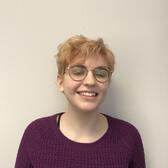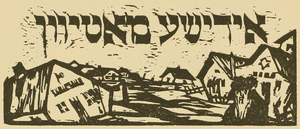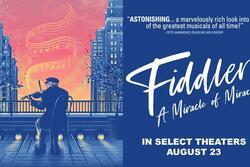Yiddishes, Alive and Dead
For so many of us in America today, Yiddish is the language of a mythicized shtetl, or maybe of borscht-belt humor, or gefilte fish. It is sepia-toned and smells like a retirement home. That’s certainly how I thought of it until this past summer, when I attended the YIVO summer program—a six-week intensive Yiddish immersion course at the YIVO Archive in New York, which is one of the biggest centers for Jewish history, and specifically for Yiddish study, in the world.
While there, I was exposed to several different “Yiddishes,” or dialects of the language that were and, in some cases, still are spoken.. At YIVO, I learned that the dialect my grandfather spoke in bits and pieces is called Litvak Yiddish.
In one of the first classes of the program the professor asked us if we remembered any Yiddish from our childhoods. Most of us had few or no words. The only Yiddish I remembered was from my grandfather. When I was very small, before his Alzheimer’s took his memory away, he called me a “shayne punim,” “beautiful face” in Yiddish. He pronounced “Punim,” meaning “face,” more like “ponim,” with a short “o” rather than a “u” sound.
I shared this with my class, making sure to mimic my grandfather’s pronunciation.
“You’re a Litvak!” said Feygele, my classmate. She learned Yiddish as her first language, but had decided to attend the YIVO program to understand the grammar. Apparently, my pronunciation of punim was distinctive.
I checked with my aunt, and Litvak, it seems, we were—meaning my family came from the region that is now Lithuania and northern Poland. Somehow, the pronunciation of this one word had survived through three generations and was enough to clue Feygele in to the origins of my family’s Yiddish.
With that knowledge, I started my journey at YIVO. Like hundreds of lefty, young, non-Orthodox Ashkenazim who feel alienated from some imagined heritage patched together from vague ideas of “the shtetl” and “the old country,” I was learning Yiddish. And it wasn’t performative, either—I was learning a real dialect, that my real family spoke!
Then, I realized that the Yiddish-speaking world is full of rifts small and large. For instance, I was excited to have the chance to see the successful Broadway version of Fiddler on the Roof that is currently being performed in Yiddish with my classmates. But my Yiddish theater teacher sneered at it. “I mean, none of the cast even speak real Yiddish!” he said. “It sounds like gibberish!” I cannot confirm or deny that assertion, as I did not end up seeing the play, but the soundtrack on Spotify certainly doesn’t sound like gibberish to me.
The matter of which Yiddish is the “real” Yiddish continued to come up throughout the six-week program. My friend Rivka, who was raised in a Crown Heights Hasidic community, told me that she was at YIVO because, although she grew up speaking a mixture of Yiddish and English as her first language, she wanted to learn more. She’s planning to work as a psychologist in the Hasidic community, and knows that there are still some elders who speak only Yiddish. She wants to be able to communicate better with them, but had worried that the Yiddish taught at YIVO would be too academic, too fossilized in pre-Holocaust European modes of speaking, to be useful to her.
Perhaps, she worried, YIVO’s Yiddish had lost its connection to “real” Yiddish, just like my professor accused the Yiddish Fiddler production of doing. For Rivka, though, that was mostly not the case. True, she occasionally grumbled about how people would look at you funny if you said some phrase we were learning at a Crown Heights Shabbat, but by and large, we all sang the same songs and laughed at the same jokes.
During the last week of classes, someone asked another one of my professors what the point of learning academic Yiddish was. She became visibly upset. “This isn’t academic Yiddish!” she explained (in Yiddish). “This isn’t some kind of academic language. This is the real language my father spoke. It’s such a shande (shame) that people call what I speak “academic,” when it’s the language of my father’s life...my family’s language!”
So, while Rivka and her family members expressed doubts about the usefulness of the Yiddish at YIVO, and people at YIVO called Hasidic Yiddish broken and strange, both groups believe themselves to be the real Yiddish-speakers, even though the differences between the two are few.
For Rivka, and for my professors, Yiddish is anything but a relic. It can be a language of feeling, of sophistication, of revolution. We must look critically at the Jewish left’s adoption of Yiddish, as it is hardly the only language we collectively have access to in order to draw strength from our heritage, and the emphasis on Yiddish can leave lesser-known Jewish languages like Ladino and Judeo-Arabic ignored. But the rise in Yiddish as a language of protest has, at the same time, helped people see meaning in the tongue of their ancestors in the world today.
A few weeks ago, on a livestream for Never Again Action, I spoke Yiddish. “As you can see,” I told the audience of thousands of people that watched, “This sign is written in Yiddish script. It says ‘Yidn Kegn ICE,’ ‘Jews against ICE.’” Yiddish for me, in that moment, became less a language of the past and more a tool for communication in the urgent present day. Yiddish argues with itself, and that is how I know it is still something that matters.








Enjoyable article. My experience of the Yiddish Fiddler on the Roof had initiated a nostalgic longing rising inside, for the many familiar conversations which had swirled around me during my childhood. I’d spoken with my grandparents, parents, and relatives in my broken Yiddish, their fluent Yiddish, in our fluent Hebrew and English, and in a bit of the other languages my grandparents knew: a combination of Yiddish Hebrew English Polish Russian German and French. In the theatre, the European sounding vocalisms and mannerisms of Fiddler were a reminder but, hadn‘t matched my memory banks, not enough to evoke nor echo those haimieshe Yiddish voices of past elder generations, once vibrant, now long gone I felt saddened because the accents and distinct verbal flair were missing. Still, gladness filled my heart in the hopes that creations like these might attract native Yiddish speakers to the task of repeating the musical in Yiddish, thus offering for our kinderlach the true Yiddish flair.